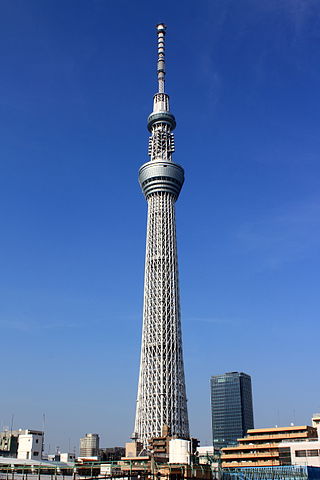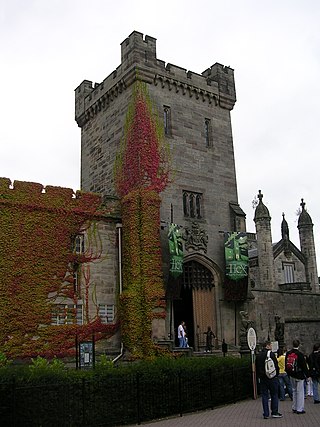
A tower is a tall structure, taller than it is wide, often by a significant factor. Towers are distinguished from masts by their lack of guy-wires and are therefore, along with tall buildings, self-supporting structures.

Magas is the capital town of Ingushetia, Russia. It was founded in 1995 and replaced Nazran as the capital of the republic in 2002. Due to this distinction, Magas is the smallest capital of a federal subject in Russia. In 2019, it had a population of 8,771 inhabitants, up from 5,841 in 2010 and 272 in 2002.

Mount Wellington, also known as kunanyi in palawa kani and gazetted as kunanyi / Mount Wellington, is a mountain in the south-east of Tasmania, Australia. It is the summit of the Wellington Range and is within Wellington Park reserve. Hobart, Tasmania's capital city, is located at the foot of the mountain.

The San Gabriel Mountains comprise a mountain range located in northern Los Angeles County and western San Bernardino County, California, United States. The mountain range is part of the Transverse Ranges and lies between the Los Angeles Basin and the Mojave Desert, with Interstate 5 to the west and Interstate 15 to the east. The range lies in, and is surrounded by, the Angeles and San Bernardino National Forests, with the San Andreas Fault as its northern border.

Ingushetia or Ingushetiya, officially the Republic of Ingushetia, is a republic of Russia located in the North Caucasus of Eastern Europe. The republic is part of the North Caucasian Federal District, and shares land borders with the country of Georgia to its south; and borders the Russian republics of North Ossetia–Alania to its west and north and Chechnya to its east and northeast.

The Sacred Heart Cathedral is a Catholic church in Sarajevo; commonly referred as the Sarajevo Cathedral, it is the largest cathedral in Bosnia and Herzegovina. It is the seat of the Archbishop of Vrhbosna, currently Tomo Vukšić, and center of Catholic worship in the city. The cathedral is located in the city's Old Town district.
Ingush, historically known as Durdzuks, Gligvi and Kists, are a Northeast Caucasian ethnic group mainly inhabiting the Republic of Ingushetia in central Caucasus, but also inhabitanting Prigorodny District and town of Vladikavkaz of modern day North-Ossetia. The Ingush are predominantly Sunni Muslims and speak the Ingush language.

Mount Pisgah is a mountain in the Appalachian mountain range and part of the Blue Ridge Mountains of North Carolina, United States. The mountain's height is 5,721 feet above sea level, and it sits approximately 15 miles southwest of Asheville, near the crossing of the boundaries of Buncombe, Haywood, Henderson and Transylvania counties. It is located on the border of Buncombe and Haywood counties, close to the point where Henderson and Transylvania meet them, but not actually within the latter two counties. The mountain is easily accessible via a hiking trail from the Blue Ridge Parkway, near the Pisgah Inn.

The state flag of Ingushetia, a republic in the Russian Federation, is a horizontal tricolour that shows a red triskelion solar sign on a white background, with narrow green horizontal stripes above and below. The white symbolizes purity of thoughts and actions, the green—the awakening of nature, abundance, fertility of the land of Ingushetia, as well as Islam, which the Ingush profess, red—the difficult struggle of the Ingush people against injustice, for the right to live on the land of their ancestors in peace and harmony with neighboring peoples throughout centuries; the solar symbol symbolizes the endless development leading to the prosperity of the Ingush people.

A gin pole is a mast supported by one or more guy-wires that uses a pulley or block and tackle mounted on its upper end to lift loads. The lower end is braced or set in a shallow hole and positioned so the upper end lies above the object to be lifted. The pole is secured with three or more guys. These are manipulated to move the load laterally, with up and down controlled by the pulley or block. In tower construction, a gin pole can also be “jumped” up the completed sections of a tower to lift the higher sections into place.

Beacon Mountain, locally Mount Beacon, is the highest peak of Hudson Highlands, located south of City of Beacon, New York, in the Town of Fishkill. Its two summits rise above the Hudson River behind the city and can easily be seen from Newburgh across the river and many other places in the region. The more accessible northern peak, at 1,516 feet (462 m) above sea level, has a complex of radio antennas on its summit; the 1,595 feet (486 m) southern summit has a fire lookout tower, which was built in 1931.

Hex – The Legend of the Towers is a walkthrough dark ride experience at Alton Towers. The ride is based on an interpretation of the local legend of the Chained Oak Tree and is set within the restored ruins of the Towers themselves. It is narrated by the actor Jim Carter.

Mount William is a mountain of the Grampians Mountain Range, located within the Grampians National Park, in the Australian state of Victoria. The mountain is situated approximately 250 kilometres (160 mi) west-northwest of Melbourne on the eastern edge of the national park, approximately 22 kilometres (14 mi) drive south from Halls Gap.
During the 13th and 14th centuries, the Mongols launched two long, massive invasions of the territory of modern Chechnya and Ingushetia, which included the lands of Alania in the west, Simsir in the northeast, and the Georgian-allied polity of Durdzuketia in the south. They caused massive destruction and human death for the Durdzuks, but also greatly shaped the people they became afterward. However, this came at great cost to them, and the states they had built were utterly destroyed, as were their previous organized systems. These invasions are among the most significant occurrences in Chechen and Ingush history, and have had long-ranging effects on Chechnya, Ingushetia and their peoples.

The coat of arms of Aarhus is an official symbol of Aarhus based on one of the oldest surviving seals of the medieval Danish market towns. The coat of arms can be traced back to a seal used in Aarhus around 1250. The oldest known preserved seal was in a document from 24 June 1356 which was lost in destruction during the Second World War. The seal has had a number of different forms during its 750 year long existence.

Dzheyrakh-Assa Museum-Reserve is a Ingush cultural and historical landscape in Ingushetia, consisting of a number of reserves and auls. In the territory of 64 thousand hectares there are about five hundred stone architectural complexes: Ingush towers and funerary crypts, Pagan and Christian shrines and temples. The first towers date back to the II millennium BC.
Mount Tuscarora is a mountain in the Southern Tier of New York. It is in Allegany State Park in Coldspring, Cattaraugus County. In 1928, a 60-foot-tall (18 m) steel fire lookout tower was built on the mountain. The tower remains on the mountain but needs to be restored. The peak is the tallest in the Allegany State Park among those that have a trail to the summit, at 2,144 ft above sea level.

Falkhan is a rural locality in the Dzheyrakhsky District of Ingushetia, Russia. It is part of the Lyazhgi rural settlement.

Koki is a medieval village (aul) in the Dzheyrakhsky District of Ingushetia. It is part of the rural settlement of Guli. Koki is the ancestral village of Ingush clan (teip) Kokurkhoy.

Ingush towers are medieval Ingush stone structures used as residences, signal posts, and fortifications. Most are found in the Sunzhensky and Dzheyrakhsky Districts of Ingushetia, North Caucasia.















